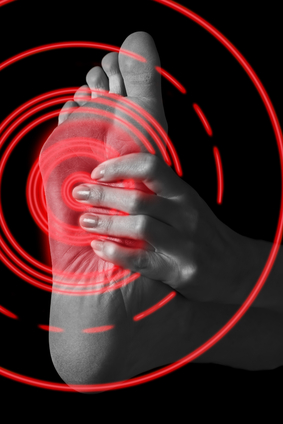Recently a woman came in to see me who was suffering from severe plantar fasciitis pain, her arch hurt so much she could barely walk. She’d been to several specialists and has so far bought three pair of orthotics (at $400 each!). Plantar fasciitis is getting to be a commonplace condition in my office. I love working with athletes, but I’m finding this isn’t only a problem for athletes.
Because of driving a car for long distances her right foot was worse then her left, which makes sense since the muscles that enable you to press down on the gas and brake pedals, are the same ones that are the cause of plantar fasciitis.
Muscles are rarely considered when searching for the answer to plantar fasciitis pain.
Instead the foot is considered to be the problem, instead of the symptom, and orthotics are commonly recommended. In many cases, when muscles are the cause of the plantar fasciitis symptoms, the orthotics will cause more pain.
The analogy I always use is, if you pull your hair at the end, your scalp will hurt. But you don’t need to massage your scalp, you don’t need to take pain-killers for the headache, and you don’t need brain surgery — you just need to let go of your hair! It’s the same with joint pain. Muscles pull on tendons, and the tendons insert into a joint. When the muscle is tight you will feel the pain at the joint. But you don’t need to rub the joint, or take pain-killers, or have surgery—you need to release the spasms in the muscle fibers.
In the case of plantar fasciitis, the muscles are in your lower leg, and the insertion of the tendon is in your arch – so when the muscles are tight your arch will hurt.
The two muscles are the tibialis anterior and the peroneals. The tibialis anterior runs along the entire length of the shin bone and then the tendon inserts onto the first metatarsal (the long bone that is on the inside of your arch and goes up to your big toe), while the peroneals run along the entire outside of your lower leg, goes behind your ankle, and the tendon inserts on the fifth metatarsal (the bone on the outside of your foot) and also on the first metatarsal at the same point as the insertion of your tibialis anterior. This is important to visualize so you can see how the tendons pulling on the bones will put pressure your arch and cause the arch muscles to be strained — causing plantar fasciitis pain in the bottom of your foot.
If you are suffering from plantar fasciitis, you’ll find the easy-to-do treatment demonstrated in Treat Yourself to Pain-Free Living, and you can use either a tennis ball (if your muscles are very tender) or the Julstro Perfect Ball to get deeper into the muscle fibers that are causing the problem.
You’ll be thrilled when you see how quickly you’ll feel relief! You’ll be able to go back out and enjoy your life pain-free!
Wishing you well,

P.S. You can read about the logic of the body and why repetitive strain injuries to muscles can cause so much pain by going to https://julstromethod.com

